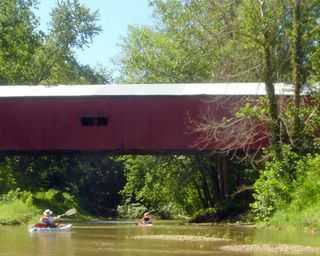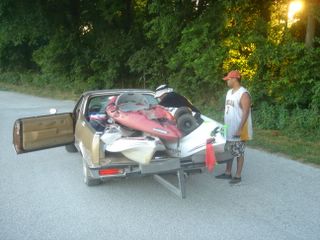Driving north on Parke County 600 at a point where the drainage ditch is several feet below the road, a bird appeared at my right as if to merge but splayed out his wings and red tail feathers to drop upon some unlucky prey. I had not seen a
red-tailed hawk from this perspective before.
I passed him as he settled into the ditch and that's how I got such a good look at him.
A few miles north, I parked in the shade and waited for the others to arrive at a covered bridge over Sugar Creek, the
West Union Bridge, our take-out.
We left my truck there and took two vehicles and 4 kayaks to the
Jackson Bridge a few miles upstream. If you asked someone to paint a picture of a covered bridge, you'd get red but the Jackson Bridge is white and I'll be sure to get a photo of it next time. This time I focused instead on a group of horses and riders who forded the river just as we entered the stream.


The Jackson Bridge on Sugar Creek is the longest span still in use. Many of the covered bridges have white faces (or openings) and barn red sides but the Jackson has white sides. This diagram shows how it has been holding itself up since 1861.

The water level of Sugar Creek was barely enough to float us in some places and deep enough for cliff diving in others. Nancy took the lead more often than not and she has become a superior paddler. She reads the creek well and makes her kayak go where she wants. Sometimes the current runs sideways like water off the crown of a country pavement and it is best to go with it because if you don't, you'll be left on a sandbar. The current will swirl downstream and give you a good ride and you can look ahead to the next adventure.
A bald eagle rose from the branch of a tree not far from the Jackson Bridge and gave us a good view of his white tail as he flew slow and low downstream before us as if to say I'm not afraid of you; I just decided to go hunting. We encountered two other balds on the trip, closer than the first but not as spectacular. I have read that there were more than a dozen bald eagles on Sugar Creek a few years ago. I don't know it the population is growing or not. Since our school days, we have been conditioned to salute the image of the bald eagle with white head held high but it is also a privilege to see one in the wild with sparkling white tail feathers shown from below.
This link will give a feel of what we saw if you have a broadband connection.
Sugar Creek is wide as a river in some parts and although the banks are tree lined, there is little shade at midday. I allow the paddle to drip cool water on my legs. I have not found a replacement for my Chevy Truck canvas hat that I lost on the Eel River a few weeks ago. I've tried straw and I've tried canvas. The Tilley hat has some appeal but it cost 65 bucks and I'm afraid it would make me look like I'm trying too hard. It is going to be hard to find a hat that will replace my old one. The light cotton desert cap with flaps works better today than the canvas hat. It gives sun protection but doesn't make my head sweat. It sure looks dumb though.
After lunch on a shady sandbar, we continue. There are a lot of trees in the water on this second half of our trip and we pick our way through them carefully. With a little more current, we would be in trouble in this section but today it is just enough of a challenge to keep us alert. We startle a heron now and then and once in a while a sandpiper chee-wee-wees at us while crossing the creek and now and then we hear a woodpecker knocking on a tree in the distant woods but most of the noise is our own pointing out hazards to one another or wondering out loud which line to take through a run or arranging the next rest break. We cooled ourselves with a swim and then a floating rest break at a cool spot under a tree before arriving at the take-out bridge.

Bryce glides by a diving rock.


Notice the full sun at right. Good thing I was covered with SPF 45.


http://www.swparke.k12.in.us/canal/parke.htm

There is a stone column upstream from Dean in the above picture. Many years ago, I heard that we have more bridges over roads than over streams and it is only more so today but there was a time when we sent canal water on aqueducts over streams, water over water if you will. I think the column in the picture is an artifact of that time. Page down twice from
this link to see a diagram.
We used ropes, pulleys and wheels to overcome gravity on the take out then we jockeyed kayaks and trucks until we could shake hands and leave the peaceful adventure of kayaking until the next time.
Brycewest took a couple dozen excellent
pictures of the trip.





















